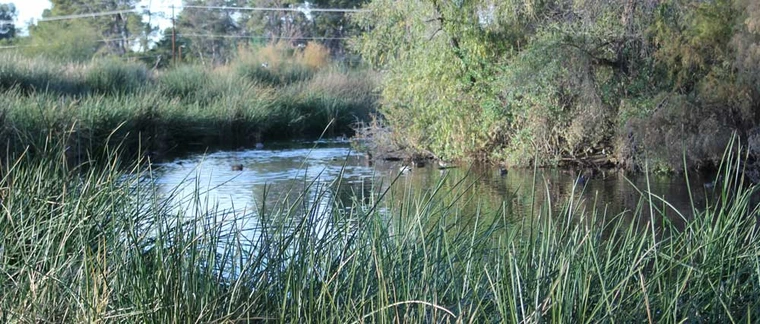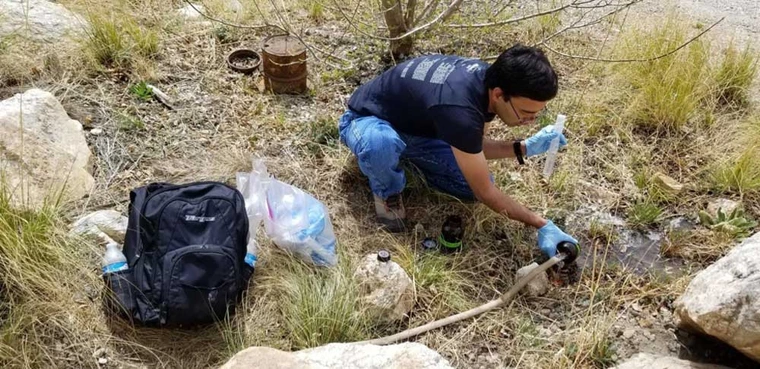
Sweetwater Wetlands
Two new water-related research projects were recently completed using funding that the Water Resources Research Center (WRRC) receives through the US Geological Survey from annual appropriations for the federal 104(b) Program. The WRRC is Arizona’s federally authorized Water Resources Research Institute, and as such administers the 104(b) Program, which provides support for research and information transfer projects on water-related issues of importance to Arizona and the region. In the past, projects funded through the WRRC have explored fundamental issues affecting the water supply, both in terms of water quality and quantity.
This year, a project led by University of Arizona professor Kevin Fitzsimmons and graduate student Robert Lynch titled “Might Recycled Wastewater Solve the Rising Problem of Toxin-Producing Algae?” explored the production of toxic algal blooms in recycled water and groundwater. The second project, “Impact of Projected Climate Changes on Mountain-block Recharge Processes” was spearheaded by hydrology professor Thomas Meixner and PhD student Ravindra Dwivedi, with input from professors Paul Ferre and Jennifer McIntosh. The study investigated mountain system recharge processes.
The Fitzsimmons and Lynch project explored the conditions that cause toxic blooms of blue-green algae in water. Although common in most water bodies around the world, blue-green algae can sometimes cause severe problems with surface water quality. When algal blooms form, water deoxygenation occurs, leading to fish kills. Furthermore, some species of algae can produce microstycins during algal blooms, deadly neurotoxins that are harmful to both humans and animals. Toxic algal blooms occur all over the world, but the environmental triggers that cause “normal” algal blooms to suddenly become toxic are poorly understood. Recent scientific advances have resulted in methods to identify genes involved in toxin production and methods to quantify trace chemicals in water samples, both of which will help in identifying environmental triggers inducing toxin production in algae.
This study compared levels of algae, heavy metals, toxic algae, and microstycins in water samples collected over one summer. Two large ponds were sampled eight times each within a six-month period. The first set of samples was taken from a pond filled with recycled water at Sweetwater Wetlands. The second set of samples came from an irrigation retention pond fed by groundwater. An exciting finding was that, while levels of toxins and toxic algae increased in the groundwater-filled pond during summer months, levels in the pond containing recycled water remained below detection limits. These results agree with a previous study that strongly indicated the presence of a factor (chemical, physical, or biological) in recycled water that prevents the formation of toxic algal blooms. Although correlations were found between toxins and some of the measured water parameters, more work needs to be done to identify factors controlling toxin formation. Knowledge of the factors inducing toxin formation would help water managers design strategies that prevent the development of dangerous water quality conditions.

Collecting water samples for major and minor cations and anions, stable water isotopes, tritium and Carbon-14 tracers, April 26, 2018.
The main objective of the second project was to improve understanding of mountain system recharge processes, specifically the processes that lead to mountain-block recharge through a fractured bedrock aquifer. Mountain system recharge is defined as the total recharge to a valley aquifer occurring from mountain systems, including water that feeds streams and valley groundwater from flow through fractured bedrock. Mountain systems provide critical water and ecosystem services for populations in adjacent alluvial basins located in semiarid and arid regions. Arizona and much of the southwestern United States rely on the water from these systems which are, worryingly, at risk due to climate change. Current climate projections indicate reduced snowpack, reduced snowpack duration, and increased frequency of extreme precipitation events. These issues compound the already uncertain recharge estimates resulting from the lack of knowledge about natural recharge processes and the hydrologic functioning of mountain systems.
Meixner, Dwivedi and their team chose a high-elevation mountainous site located within the Santa Catalina Mountains for long-term observations of multiple tracers, using multiple methods. These observations were used to evaluate multiple competing conceptual models of streamflow generation and processes affecting stream water quality. A conceptual model involving precipitation, soil water, shallow and deep groundwater proved useful for the study site. Preliminary results suggest that during periods of snowmelt the quantity of stream water at the site is maintained by shallow surface storage, such as near surface water and soil waters. On the other hand, the quality of stream water is controlled by both shallow subsurface flow and deep flow through the fractured bedrock aquifers.
The project will lead to improved understanding of recharge processes and how catchments store water and discharge it with time. The results will provide state and local water managers with better estimates of groundwater replenishment rates in lowlands through mountain systems. Study findings are also relevant to other high elevation mountainous areas where fractured-bedrock aquifers play a significant role in streamflow and groundwater recharge.

